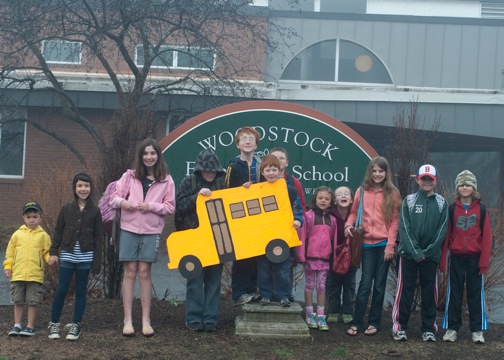
Program sparks enthusiasm for walking to school.
This piece first appeared in The Vermont Standard.
When five-year-old Hudson Maxham woke up last Wednesday morning, his first words were “walking school bus.” He’d missed out on the previous week’s “bus,” the assembly of students, parents, and teachers that once a week winds through the Village to the Woodstock Elementary School (WES) on foot, picking up kids along the way. Last week, Hudson was determined to be on board. “You don’t have to drive,” he says “and you don’t have to pay for gas either, and it’s more fun.”
The kindergartener fully grasps the essence of the program that began last spring at WES and will continue through November 17 of this school year. At 7:15 on Wednesday mornings, two groups of kids gather for the chaperoned walks. The idea, says WES Principal Karen White, is to spark enthusiasm for walking to school, and for walking in general as a means of getting around. There of course is the benefit of exercise and fresh air. But White shares Hudson Maxham’s feeling that the walking is fun. “It’s a really joyful thing to walk with children; it’s so interesting to hear what they have to say about what they see,” she says, “whether it’s an observation about cows in the field or stepping in a puddle.” Before each walk, she wonders, “What are they going to notice today?”
According to the Vermont Agency for Transportation, fewer than 15% of children nationally now walk or bike to school, down from over 70% just a generation ago. A 2006 Agency survey of over 55,000 Vermont school children paints a similar statewide picture. Chuck Wise, Senior Transportation Planner for the Two Rivers Ottauquechee Regional Planning Commission in Woodstock partly attributes the sharp drop to the “broader issue of why we all became married to the automobile; it just becomes a habit.” He adds that busy families often need to mobilize quickly, particularly in the morning, and parents today seem less comfortable letting unaccompanied children walk to school.
The Walking School Bus is an element of a national initiative, Safe Routes to School, which goes beyond simply rallying kids to walk or bike. The program is intended to improve safety and cut traffic, fuel usage, and pollution around schools. A few years ago, the United States Congress allocated program funding for grants to evaluate pedestrian routes and enhance safety with improvements like extending or connecting sidewalks, or upgrading signage. To be eligible, though, communities must first demonstrate an on-going commitment to foot power.
In Woodstock, Principal White sees a great deal of automobile traffic in front of the school at drop off and pick up times. She estimates that only a handful of students regularly walk or bike, and another fifty or sixty use the school’s three busses. That means that most of the185 students arrive and leave in cars, which pull in and back up along the limited curb space in front of WES, as non-school traffic also passes by. The situation turns into “four travel lanes, essentially,” says Transportation Planner Wise.
Last year, Wise and White put their heads together and formed a Safe Routes to School Committee, along with WES teacher Gretchen Czaja, Ottauquechee Community Partnership Executive Director Jackie Fischer, and Sustainable Woodstock Director Sally Miller. The five did the initial legwork to get the Walking School Bus going. While Wise and White both feel that an application for a Safe Routes to School grant may be possible at some time, the immediate priority is to get both parents and kids walking to school. A pedestrian “shed” map Wise developed indicates that many WES students live within the two mile radius that generally makes a walk or bike ride to school feasible. But, he points out, “it doesn’t have to be that the trip starts at home and ends at school.” Parents could also opt for dropping children at a convenient intermediate location, like one of the stops along the Walking School Bus route, then letting them hoof it the rest of the way.
When Hudson Maxham dashed to catch up with the walking bus last week, his nine-year-old brother Jacob and seven-year-old sister Molly ran out with him. They laughed and joked with teachers as the group made its way to WES. The distance seemed short to Jacob, “I don’t know how many miles it is,” he says, “probably like only one.” Molly imagined racing with the regular bus. “Last year when we did this we beat the bus to school,” she boasts. All three Maxham children have the chance to become “Roads” Scholars, a title Principal White plans to confer on students who participate in at least eight walks.
Students and parents can join the Walking School Bus along either of two routes, each about a mile long. A group meets at the Billings Farm overflow parking lot, heads south on Route 12, walks down River Street to Mountain Avenue, through the Middle Covered Bridge and across the Green to South Street. Another group gathers at Lincoln and Thomas Streets, proceeds down Lincoln to Central Street, turns onto High Street and then Cross Street. Teachers and parents chaperone both groups. The children keep to available sidewalks, and cross streets only in marked crosswalks.
